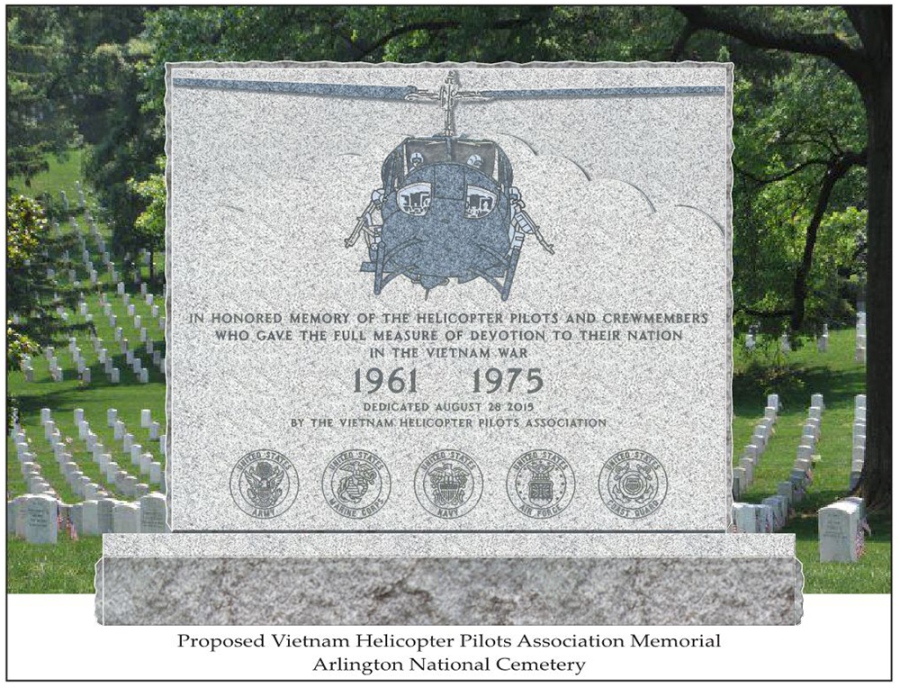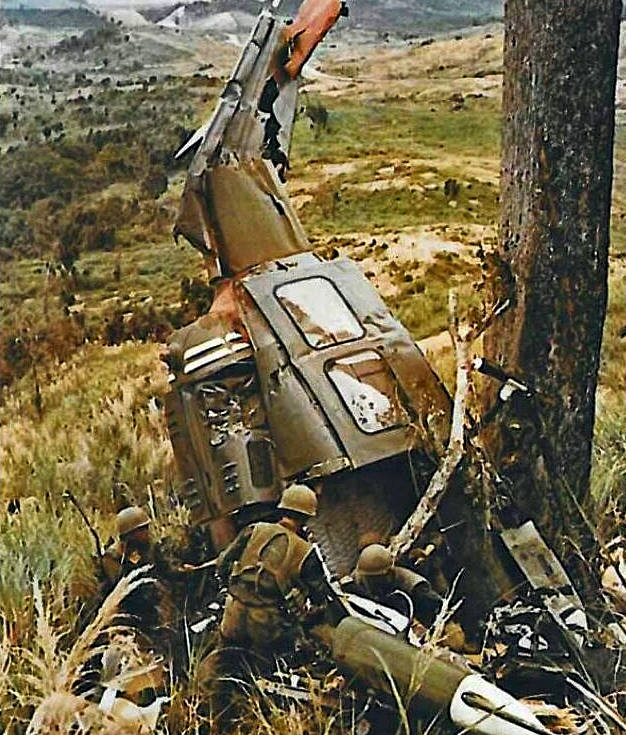
Between 1961 and 1975, tens of thousands of U.S. military helicopter pilots, crew chiefs, gunners and medics spearheaded U.S. efforts to secure the 67,000 square miles of South Vietnam. They ultimately lost to the North Vietnamese. Now, a half-century later, they are fighting once again. This time, their ranks thinned by age, they are fighting for a more modest piece of territory: five square feet in Arlington National Cemetery. Once again, they are losing. This time, the enemy is the U.S. Army.
Vietnam has long been known as the “Helicopter War.” The distinctive “thump-thump” of UH-1 Huey choppers is seared deeply into the memories of Vietnam veterans, and even many Americans who only heard it on the evening news or recall it from Apocalypse Now. It was where the Army rolled out its notion of “air mobility”—skies full of helicopters rushing troops to the front, plucking them from trouble, rescuing the wounded, and bringing home the dead.
About 12,000 U.S. military helicopters spent 7.5 million hours above Vietnam, flying 2 million missions. “The aviation units were the sole combat element of the U.S. Army that did not come apart under the stress of the war in Vietnam,” Neal Sheehan wrote in A Bright Shining Lie, his Pulitzer Prize-winning 1988 classic about the war. “The Army airmen never cracked.”
A total of 5,086 choppers, about 42%, were destroyed by enemy fire, bad weather, mechanical snafus and the other bad hands war routinely deals those sent to fight it. The toll among those who flew for a living: 2,002 pilots killed and 2,704 crew chiefs and gunners dead. That’s about 7% of the 58,000 American troops killed in Vietnam. But along the way, they helped rescue more than 90,000 wounded—more than half of them American—and saved untold thousands of lives.
“I was a combat medic, and I can give you a long list of guys who are alive today solely because of medevacs,” Steve Bird says. He spent 1968 in Vietnam with the 1st Air Cavalry Division. He witnessed the valor of the chopper crews that July near the Ho Chi Minh trail when his 110-soldier company stumbled into a North Vietnamese regiment of about 700 troops. The GIs spent two days pinned down as rescue choppers made repeated tries to come to their rescue amid enemy fire before finally getting them out.
The enemy killed 14 U.S. troops, and wounded six others, including Bird, who took a round in his left shoulder. “In all the chaos and even controversy of that war, I had a mission that was pure, clean, and simple—go rescue the wounded,” says Art Jacobs, who was wounded aboard his Huey while trying to save Bird and his buddies on his third try. “For as long as I shall live, flying medevac was perhaps the finest thing I have ever done,” adds Jacobs, 70, of Brentwood, Tenn.
Four months later, Bird would be rescued by helicopter again, following a second wounding. “I can’t find words,” he says, “to express what those guys did for us.”
As the arc of the Vietnam-era pilots’ lives heads to the far horizon, the 15,000-member Vietnam Helicopters Pilots Association (VHPA) believes the bravery of their comrades killed in that war (10% of whom are buried at Arlington) deserved recognition in the nation’s most-revered burial ground. VHPA began pushing for a memorial two years ago. It promised the Army it would pay its $6,000 cost, as well as setting up a trust fund to maintain it in the future.

“Despite the Vietnam War being described as the ‘Helicopter War’ and the UH-1 Iroquois Helicopter being recognized as the iconic symbol of the war, no specific memorial exists, anywhere, strictly honoring helicopter pilots and crew members who died while serving in combat,” UPI Vietnam war correspondent Joe Galloway, told the Army in a letter advocating its approval of the Arlington monument (officially nicknamed the Iroquois, the UH-1 came to be known as the Huey, after its original designation as the HU-1). “For all the right reasons—location, numbers of interred helicopter pilots and crew members buried in commonality-of-service without regard to military branch, honor and service, no other military cemetery is suitable for placement of a memorial monument honoring the service of Vietnam helicopter pilots and crew members.”
Bob Hesselbein spent 681 hours flying AH-1 Cobra gunships over Vietnam in 1972. As VHPA’s former president, the 64-year-old has led the fight for what he calls a “small and humble” tribute to his lost brothers. Their proposed 4-by-3-foot Barre granite monument would stand atop a 5-foot base. In September 2014, the pilots’ group (later to join forces with the Vietnam Helicopter Crew Members Association, made up largely of the crew chiefs and gunners who kept the warbirds flying and protected in flight) formally sought Arlington’s approval.
But the Army’s Advisory Committee on Arlington National Cemetery deadlocked 3-to-3 on the proposal (a seventh member was MIA when the vote was taken) in March 2015. The three Vietnam veterans on the panel split: Max Cleland, a former Georgia senator and VA head who lost three limbs in Vietnam, and Thomas Kelley, who received the Medal of Honor for gallantry there, supported the monument “due to the disproportionate loss of life compared to the number of lives these pilots saved in the Vietnam conflict,” according to the panel’s minutes. James Peake, who earned a Silver Star in Vietnam before becoming an Army doctor and leading the Department of Veterans Affairs from 2007 to 2009, and two others opposed it, saying Arlington should not become “a monument park.”
The panel’s stalemate ended up on the desk of John McHugh, then the Army secretary, who had come to the Pentagon following 18 years in the House (including 16 on the armed services committee, and 14 co-chairing the House Army Caucus). In July 2015, he told Cleland (the advisory panel’s chairman at the time) that he had “disapproved” the petition for the Vietnam helicopter monument.
“The prime directive for the cemetery is to do everything it can not to initiate an action that would displace an otherwise-eligible veteran,” McHugh told TIME on Thursday. “On a very tough decision, that philosophy and unwritten rule was the determining factor.”
Arlington, where more than 400,000 have been interred since 1864, has only enough land for burials until the mid-2030s, the Army says. That makes every square foot of its 624 acres precious (a pending proposal to add 38 acres could give Arlington another 20 years’ worth of room). “Space wasn’t a concern until these recent theaters of combat in Afghanistan and Iraq,” says McHugh, a Republican who left the Army’s top civilian job last October, after more than six years in the post. “There was a period I was attending three funerals a day for the fallen, and you have to be very mindful of what the future may bring.”

While memorials are sprinkled throughout Arlington’s sacred grounds, ranging from the well-known (the Tomb of the Unknown Soldier) to the largely forgotten (the Argonne Cross) to the jarring (the Confederate Memorial), there have been few added in recent years. The last two, both ordered by Congress, acknowledge World War II’s Battle of the Bulge (2002) and Jewish chaplains (2011).
The Army’s formal refusal has been a bitter blow for the proud men (and they were all men) who flew helicopters in Vietnam. “The best and the brightest might be buried at Arlington National Cemetery, but based on its management, they don’t work there,” Hesselbein, of Madison, Wis., says. “I’d say 1,000 deaths—not casualties, but deaths—per square foot is worth a monument—5,000 dead in five feet.” They argue that there is space unsuitable for burials because of tree roots or underground utility lines where their memorial could rest.
It also has upset veterans like Bird who are indebted to their rescuers. “We’re dealing here with pencil-pushing bureaucrats who have no fricking clue what they’re doing,” says Bird, of Groveland, Mass. And he doesn’t buy the Army’s justification. “There’s memorials all over that damn cemetery for every Tom, Dick and Harry cause that you can think of,” Bird says. “And these jerks in the Army are giving them a hard time over a few square feet? It’s preposterous.”
Arlington officials say their emphasis is to honor individuals, not groups, even if it’s in the form of a so-called memorial marker placed without a body underneath. “The most important monument at that cemetery are the individual headstones,” Patrick Hallinan, a one-time Marine who used to run Arlington and is now in charge of all Army cemeteries. He added that the Army doesn’t want to surrender even five square feet. “Any space that we would designate for that purpose could still be used in the future for burial or for memorial marker for someone that’s missing,” he told Congress Sept. 8. “I understand that, ‘Hey, it’s only five feet,’ but five feet is a grave site.”
Bird, despite his 69 years, retains a young grunt’s disdain for authority. “They found a place in Arlington to bury Ruth Bader Ginsburg’s husband, because she is a Supreme Court justice and wants to be buried there,” he says, referring to the 2010 interment of Martin Ginsburg (the Obama Administration made the decision). “There’s going to be guys rolling over in their graves when they find out she’s in the ground there,” he predicts. “They can find a spot for that guy, but they can’t find a spot for a memorial like this?”
While the Army rejected the memorial, it did approve the VHPA’s gift of a 20-foot red maple to replace a dying tree on the cemetery grounds. It was planted last year. The service also said the group could have a 12-by-18-inch plaque near the tree honoring their service. The chopper crews have declined to seek the plaque, at least for now, while they seek a congressional reversal of the Army’s decision vetoing the monument. A bipartisan group of 26 lawmakers is pushing to do just that.
Hesselbein and his fellow pilots seem resigned to whatever remembrance they get. “Vietnam did not turn out well, and it’s kind of an embarrassment to the great military history of the United States,” he says. “They’re just hoping we all die.”
More Must-Reads from TIME
- Donald Trump Is TIME's 2024 Person of the Year
- Why We Chose Trump as Person of the Year
- Is Intermittent Fasting Good or Bad for You?
- The 100 Must-Read Books of 2024
- The 20 Best Christmas TV Episodes
- Column: If Optimism Feels Ridiculous Now, Try Hope
- The Future of Climate Action Is Trade Policy
- Merle Bombardieri Is Helping People Make the Baby Decision
Contact us at letters@time.com